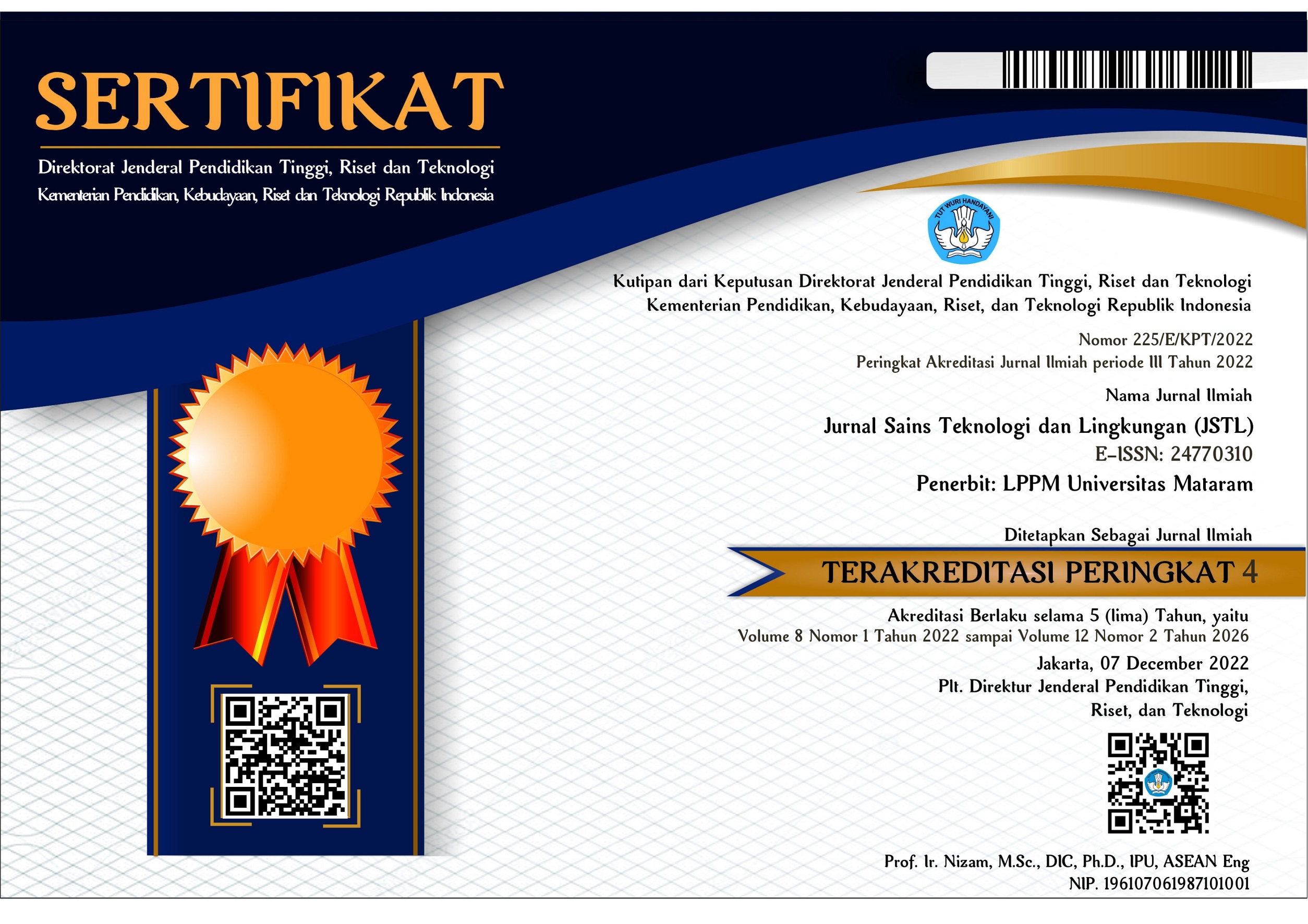Potensi Bibit Sotong untuk Pengembangan Keragaman Budidaya Nelayan Kecil sebagai Strategi Konsevasi Lamun di Perairan Pesisir Lombok Timur
DOI:
https://doi.org/10.29303/jstl.v5i2.118Keywords:
environment, diversification, conservation, potentialAbstract
Diversification of marine culture has an effective value for the sustainability of the livelihoods of small fishermen. In addition it can play a role in preventing the threat of utilization that is not environmentally friendly. Cuttlefish is one of the types of marine biota commodity that has high economic value and has the potential to be developed as a fishery diversification community. The purpose of this study was to determine the indicators of the potential of cuttlefish cultivation as a diversification strategy for small fishermen's cultivation and seagrass conservation in the study location. The research method used is the method of direct observation and interviews. Data analysis uses descriptive statistical analysis. The results showed that the average cuttlefish seedlings were 1293.5 individuals / month and the average cuttlefish caught by fishermen landed at TPI Tanjung Luar was 1229 individuals / month consisting of three species namely Sepia latimanus, Sepia pharaonis and Sepioteuthis lessoniana. In addition, marine cultivation has developed into the choice of livelihood for small fishermen, although it is still complementary. Furthermore, the group of farmers plays an active role in preventing local threats from uses that are not environmentally friendly. The conclusion is the diversification of cultivation with cuttlefish community is of strategic value to overcome the problem of the sustainability of small fishing livelihoods and local scale seagrass conservation in the study location. Therefore, diversification of cuttlefish culture can be considered, especially at the scale of small fishermen as a policy of developing seafood products to achieve food security, both at local, regional and national scale.References
Bahrawi, S., Komarudin, A.K.U., dan Arfiyanto, A. 2014. Aplikasi penangkapan benih Lobster dengan menggunakan lampu. Direktorat Jenderal Perikanan Budidaya Departemen Perikanan dan Kelautan Republik Indonesia. Proseding Indonesia Aquaqulture 2014, Aquaculture for Bussines and Food Security, 344 hal.
Cadman, J., Zhou, S., Chen, Y., & Li, Q. (2012). Cuttlebone: characterisation, application and development of biomimetic materials. Journal of Bionic Engineering, 9(3), 367-376.
Correia, M., Palma, J., & Andrade, J. P. (2008). Effects of live prey availability on growth and survival in the early stages of cuttlefish Sepia officinalis (Linnaeus, 1758) life cycle. Aquaculture research, 39(1): 33-40.
de la Torre-Castro, M., Carlo, Gdi., dan, Jiddawi, N.S,. 2014. Seagrass importance for a small-scale fishery in the tropics: The need for seascape management. Mar Pollut Bull; 83:398-407.
Duysak, Ö. Özcan, G., Çek, Ş., & Türeli, C. (2014). Reproductive biology of the common cuttlefish (Sepia officinalis Linnaeus, 1758) in Iskenderun Bay (Northeastern Mediterranean Sea). Indian journal of Geo-Marine Sciences, 43 (9): 56-65.
Galappaththi, E.K., dan Berkes, F. 2014. Institutions for managing common-pool resources: the case of community-based shrimp aquaculture in northwestern Sri Lanka. Maritime Studies, 3:1-16.
Grech, A., Chartrand-Miller, K., Erftemeijer, P., Fonseca, M., Kenzie, L. Mc., dan Rasheed M, 2012. A comparison of threats, vulnerabilities and management approaches in global seagrass bioregions. Environ Res Lett, 7:1-6.
Hossain, K., dan N. Saintilan. 2007. Lingkages between seagrass, mangrove and saltmarsh as fish habitat in the Botany Bay estuary, New South Wales. Wetlands Ecol Manage.15: 277–286.
Iglesias, J., Fuentes, L., Villanueva, R., 2014. Cephalopod Culture. Springer, Netherlands. 494 p. ISBN 978-94-017-8647-8
Kim, B. S., Kim, J. S., Sung, H. M., You, H. K., & Lee, J. 2012. Cellular attachment and osteoblast differentiation of mesenchymal stem cells on natural cuttlefish bone. Journal of Biomedical Materials Research Part A, 100(7), 1673-1679.
Lebel, L., Mungkung, R., Gheewala, S.H., dan LebelInnovation, P. 2010. Innovation cycles, niches and sustainability in the shrimp aquaculture industry in Thailand. Environmental Science and Policy, 13(4): 291–302.
Lee, S.Y., Primavera, J.H., Dahdouh-Guebas, F., Kee, K.Mc. Bosire, J.O., dan Cannicci, S. 2014.Ecological role and services of tropical mangrove ecosystems: a reassessment. Glob. Ecol.Biogeogr. 23:726-743.
Liu, H., Luo, P., Chen, S., & Shang, J. 2011. Effects of squid ink on growth performance, antioxidant functions and immunity in growing broiler chickens. Asian-Australasian Journal of Animal Sciences, 24(12), 1752-1756.
Nadiarti, N.E, Djuwita, I., Budiharsono, S., Purbayanto, A., dan Asmus, H. 2012. Challenging for Seagrass Management In Indonesia. Journal of Coastal Develpopment, 15 (3): 234-242Ozyurt G., Duysak O., Akamca E., Tureli C. 2006. Seasonal Changes of Fatty Acids of Cuttlefish Sepia Officinalis L. (Molusca: Cephalopoda) in the north eastern mediteranean sea. Food Cemistry 95 (3): 382-385.
Santoso, D., Baskoro, M.S, Simbolon, D., Novita, Y., dan Mustaruddin. 2015. The Status and Utilization Rate of Squid (Loligo edulis) in Alas Strait at West Nusa Tenggara Province. IJSBAR, 20 (2): 296-303.
Setyohadi, D., Sunardi, S., Mukhlis, N., & Cahya, C. N. 2016. Cuttlefish (Sepia Spp) Identification and Biological Analysis of A Dominant Cuttlefish Species Landed in Muncar, Banyuwangi Regency, East Java. Research Journal of Life Science, 3(2): 109-118.
Sykes, A.V., Domingues, P., Andrade, J.P., 2014. Sepia officinalis. In: Iglesias J, Fuentes L, Villanueva R (eds) Cephalopoda Culture. Spinger Netherland, hal 175-204.
Syukur, A, Mahrus, dan Syachruddin. 2015. Environment friendly fish farming and seagrass conservation as an instrument of economics development of small-scale fishermen in coastal waters of Tanjung Luar East Lombok. Paper presented in the International Seminar on Tropical Natural Resources, University of Mataram.
Syukur A., Mahrus, dan Syachruddin. 2016. The potential assessment environment friendly aquaculture of small-scale fishermen as a conservation strategy seagrass beds in coastal areas of Tanjung Luar East Lombok, Indonesia. International Journal of Fisheries and Aquatic Studies, 4 (2): 22-27.
Syukur, A., Mahrus, Syachruddin, AR. 2019. Relevansi Budidaya Ramah Lingkungan Terhadap Perlindungan Lamun Skala Lokal Di Pesisir Lombok Timur. JPPIPA: 5 (1): 1-12.
Unsworth, R.K.F., Hinder, S.L, Bodger OG, dan Cullen-Unsworth, L.C. 2014. Food supply depends on seagrass meadows in the coral triangle. Environ Res Lett, 9:1-9.
Vidal, E. A., Villanueva, R., Andrade, J. P., Gleadall, I. G., Iglesias, J., Koueta, N., & Albertin, C. B. (2014). Cephalopod culture: current status of main biological models and research priorities. In Advances in marine biology (Vol. 67, pp. 1-98). Academic Press



1.png)











